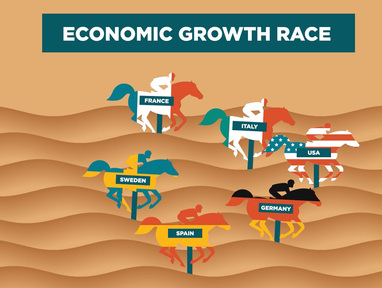Social Safety Nets
How Big Is The US Social Safety Net?
It can be difficult to keep track of the many federal transfer programs that compose the safety net. The programs have distinct eligibility requirements, they are administered by different federal agencies or by states, and their funding comes from various sources. Fully describing all of the programs would take far too long, but a brief overview of the largest programs will be helpful in understanding the state of the safety net.
When you think of the safety net, you might focus on cash-assistance programs, where money is given directly to individuals or families. These programs include Social Security and the Supplemental Security Income (SSI) program, which provide cash assistance for seniors and the disabled. The Temporary Assistance for Needy Families (TANF) program gives grants to states for cash assistance to poor families with children. The Earned Income Tax Credit (EITC) provides tax credits to low-income workers.
But there are also many programs that provide in-kind benefits—goods or services—to eligible populations. The Supplemental Nutrition Assistance Program (SNAP), the successor of the food stamp program, provides food subsidies to low-income households. The Child Nutrition program provides free or reduced-price breakfasts and lunches to children. Medicare subsidizes health care for seniors and the disabled. Medicaid provides grants to states to provide health-care services to low-income groups, and the Affordable Care Act subsidizes the purchase of private health insurance for some Americans with incomes too high to qualify for Medicaid.
When we talk about the federal budget, we refer to most safety net programs as entitlements. This is not intended as a pejorative term but rather refers to transfer spending where federal funding is generally not subject to Congress’s annual appropriations process. In 2018, the federal government spent about $2.5 trillion on entitlement programs. In The High Cost of Good Intentions (Stanford University Press, 2017), economist John Cogan describes the reach of these programs:
Fifty-five percent of all U.S. households receive cash or in-kind assistance from at least one major federal entitlement program. Among all households headed by a person under age 65, over 40 percent receive entitlement program benefits. Eighty percent of all people living in households headed by single mothers receive entitlement benefits, and nearly six out of every ten children in the United States (58 percent) are growing up in a family on the entitlement rolls.
This video with Cogan explains the how nation’s safety net has evolved:
Who Receives Assistance?
Since the 1960s, the nation has spent tens of trillions of dollars trying to eliminate poverty. Economist Lee Ohanian breaks down how much low-income earners are now receiving from the government:
A family of four at the poverty level [in 2015] has about $22,300 per year of pre-tax income. Consumption for that same family of four on average, however, is about $44,000 per year, which means that their consumption level is about twice as high as their income. But consider the relationship between consumption and income among poverty-level families prior to Lyndon B. Johnson’s Great Society initiatives in 1964. At this time, a family of four at the poverty level was consuming only about 10 percent in excess of their income.
So entitlement programs are indeed alleviating poverty, but they do so inefficiently. As John Cogan explains in the above video, “only about 20% of all entitlement assistance actually goes to reducing poverty; a whopping $700 billion goes each year to individuals in the upper half of the income distribution.”
How is this possible? While some transfer programs are limited to recipients with incomes below certain thresholds, others are given regardless of income. For example, Social Security tends to give high-income recipients larger benefits than low-income recipients. Cogan calculated that married seniors with significant pre-retirement income could receive over $1 million in Social Security and Medicare benefits during their lifetimes.
How Do These Programs Affect Work And Savings?
Benefits for many safety net programs are linked to incomes of recipients. As incomes rise, benefits generally fall. You can think of these benefit reductions as a tax: a recipient earns an extra dollar of wages, but, after accounting for the reduction in benefits, the recipient is better off by less than one dollar. For example, in the case of SNAP, every dollar a recipient earns above certain thresholds reduces SNAP benefits by 24 cents. This is necessary to prevent the rich from qualifying for assistance, but the benefit reductions discourage some recipients from seeking employment or working more.
Since recipients may be enrolled in many programs, each with their own benefit reduction formula, the result can be very high effective marginal tax rates on low-income families. If we include reductions in benefits, payroll taxes, income taxes, and state taxes, the effective marginal tax rates some recipients face can exceed 50%. Faced with such high effective tax rates, it is no wonder many recipients choose to forgo work.
Watch this video discussing how tax rates affect working and saving decisions:
But even safety net programs that don’t reduce benefits as incomes rise (e.g. Social Security, Medicare) may still discourage work and savings. Social Security, for example, encourages workers to retire earlier than they otherwise would and to save less for retirement. Here is John Cogan explaining how these disincentives to work and save affect recipients and the economy:
How Big Will These Programs Be In The Future?
Spending on these programs is expected to rise dramatically over the next 30 years. Right now, 67% of the federal budget (excluding interest payments) goes to entitlement programs. By 2049, this figure will rise to 77%. Growth in Social Security, Medicare, and Medicaid comprise the majority of the spending increase. As a share of the nation’s economy, spending on these three programs will rise from 9.7% to 15%.
The explanations of the growth in these programs vary. Medicare and Social Security are experiencing rapid enrollment increases as baby boomers retire. On top of that, benefits per enrollee are expected to rise. Social Security benefits are linked to wage growth, which means future retirees will receive higher real benefits (i.e., after adjusting for inflation) than current retirees. Medicare and other federal health-care programs face rising medical costs, and future enrollees are expected to use more medical services than prior enrollees.
What are the consequences of this growth in spending? Economist John Cochrane argues:
Our entitlements are, no surprise, on an unsustainable path. We will either reform them, in a way that reduces federal spending, or we will substantially raise taxes on the “middle class,” including a large payroll tax increase and likely a European style VAT on top of growth-killing income and corporate taxes.
Without reforming entitlement programs or substantially raising taxes, the result will be skyrocketing federal debt levels. That debt will destabilize the economy and threaten the security and prosperity of future generations. You can read more about the dangers of rising debt in this recent Policy Insight piece.
Is There A Better Way To Help The Poor?
The problems with the social safety net are not new. Here is Milton Friedman’s 1967 description of the safety net:
It is expensive and most of the money goes to people who are not by any stretch of the imagination poor. It involves a tremendous bureaucracy, wide-spread intervention into the operation of the market system in areas that have nothing to do with poverty, and inexcusable interferences with the individual freedom and dignity of the truly poor who receive assistance, let alone of the rest of us. Equally serious, it has the worst possible effect on incentives because a dollar earned and revealed is a dollar of relief lost. It tends to produce poor people, and a permanent class of poor people living on welfare, rather than to help the unavoidably indigent.
Since then, several new transfer programs have been created, others have been expanded, and a handful have been reformed. But, as we have seen, nothing much has changed. The social safety net still fails to target those in poverty, continues to discourage work and savings, and now costs trillions of dollars.
Can we reform these programs to improve outcomes for recipients and cut costs?
In the Blueprint for America, John Cogan outlines a series of reforms that would reduce the future costs of transfer programs and improve the incentives of these programs. The Social Security benefit formula would be indexed to prices, ensuring future retirees will receive the same real benefit as today’s retirees. To slow enrollment growth, the retirement age would be gradually raised. Medicare recipients would be given vouchers to purchase private health insurance, and coinsurance rates would be modestly raised on recipients. Cogan argues the Medicare reforms “will not only save taxpayer money, they will ultimately give seniors greater access to cost-effective medical care than the existing program’s combination of low copayments and increased rationing.” Finally, low-income safety net programs would be transferred back to the states, where programs could be better targeted to meet the needs of the impoverished.
Watch this Blueprint for America video to learn more:
There is precedent for these types of reforms. Cogan highlights the Welfare Reform Act of 1996 as a template:
The reform law eliminated the entitlement to AFDC [Aid to Families with Dependent Children], established a federal block grant to financially assist states, and gave states virtually complete authority to set eligibility rules and benefit levels. Since the reform law’s enactment, states have moved millions of welfare mothers from a dead-end life of dependency on government assistance to one of self-sufficiency through work. Since 1996, the number of families dependent on AFDC has declined by 60 percent, two-thirds of AFDC mothers have left the welfare program to obtain productive employment, and poverty rates among single female–headed households with children have declined. This same approach should be applied to food stamps, child nutrition programs, Supplemental Security Income, housing subsidies, Medicaid, and other welfare programs.
There are international examples of successful welfare reforms as well. This brief video explains how Sweden became a source of growth and prosperity after adopting many market-based reforms, including reforms to the country’s social safety net:
Conclusion
Reforming our welfare system is an important step in providing more economic opportunities for the next generation. More than any government program, however, the most successful way to reduce poverty is through economic growth. In this video, economist Ed Lazear highlights how America’s exceptional economy has improved standards of living for Americans:
Pursuing economic policies that promise higher economic growth is paramount in reducing poverty rates. In a follow-up to the above video, Lazear highlights some ways we can improve the US economy for future generations:
Beyond growing the economy, there are other policy changes we should pursue to reduce poverty. Economist David Henderson points to occupational licensing requirements as an impediment to economic mobility. And, in this 2015 article, Lee Ohanian focuses on reforms to K–12 education and immigration policy that could increase economic opportunity for low-income Americans.
In short, the reforms that would best help low-income families are ones that would provide them with more skills and more work opportunities. Work, not welfare, is the key.
Sources and Further Reading:
In The High Cost of Good Intentions, economist John Cogan explores the history of US entitlement programs. He shows how all entitlement programs follow a similar pattern. They begin small, targeting a specific population. Over time, however, the program inevitably expands to more people who are deemed “equally worthy” of assistance.
John Cogan highlights the themes and subjects of his book in this Uncommon Knowledge interview.
Lee Ohanian and Jesús Fernández-Villaverde discuss how Sweden reformed its welfare system. Specifically, they cut unemployment benefits and created an earned-income tax credit to encourage more recipients to enter the workforce.
Economist David Henderson cautions readers against creating a permanent entitlement program such as a Universal Basic Income (UBI). Henderson shows the high cost of the program and the work disincentives a UBI could create.







